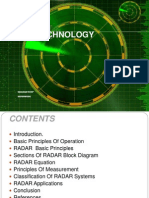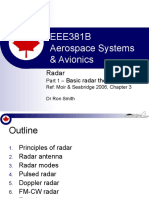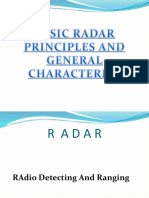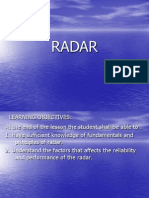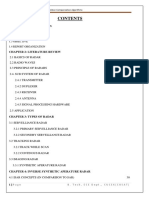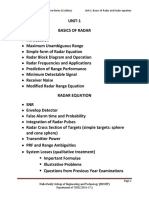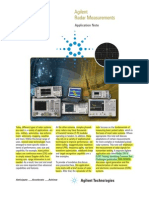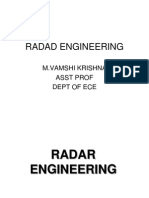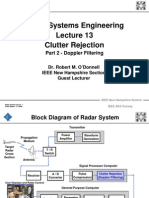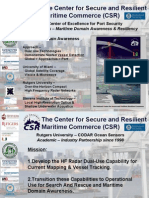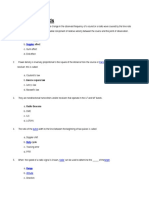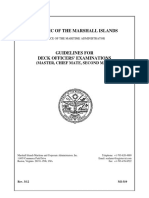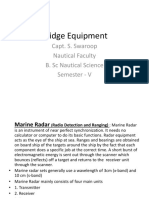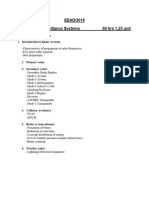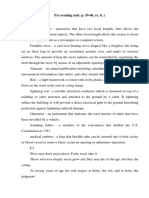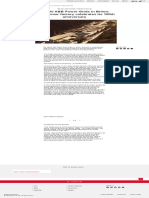100%(2)100% found this document useful (2 votes)
361 viewsFundamentals of RADAR
Fundamentals of RADAR
Uploaded by
sergiuserbanRADAR uses radio waves to detect and determine the range and bearing of objects. It works by transmitting short pulses of radio waves and measuring the time it takes for the echo signal to return. This allows RADAR to calculate the distance to targets. By determining the direction of the antenna when the echo is received, RADAR can also calculate the bearing. Targets are displayed on a screen showing their relative position to the ship. Modern marine RADAR is crucial for navigation, allowing detection of other vessels and navigation aids.
Copyright:
© All Rights Reserved
Available Formats
Download as PPT, PDF, TXT or read online from Scribd
Fundamentals of RADAR
Fundamentals of RADAR
Uploaded by
sergiuserban100%(2)100% found this document useful (2 votes)
361 views20 pagesRADAR uses radio waves to detect and determine the range and bearing of objects. It works by transmitting short pulses of radio waves and measuring the time it takes for the echo signal to return. This allows RADAR to calculate the distance to targets. By determining the direction of the antenna when the echo is received, RADAR can also calculate the bearing. Targets are displayed on a screen showing their relative position to the ship. Modern marine RADAR is crucial for navigation, allowing detection of other vessels and navigation aids.
Original Description:
Fundamentals of RADAR
Original Title
1. Fundamentals of RADAR
Copyright
© © All Rights Reserved
Available Formats
PPT, PDF, TXT or read online from Scribd
Share this document
Did you find this document useful?
Is this content inappropriate?
RADAR uses radio waves to detect and determine the range and bearing of objects. It works by transmitting short pulses of radio waves and measuring the time it takes for the echo signal to return. This allows RADAR to calculate the distance to targets. By determining the direction of the antenna when the echo is received, RADAR can also calculate the bearing. Targets are displayed on a screen showing their relative position to the ship. Modern marine RADAR is crucial for navigation, allowing detection of other vessels and navigation aids.
Copyright:
© All Rights Reserved
Available Formats
Download as PPT, PDF, TXT or read online from Scribd
Download as ppt, pdf, or txt
100%(2)100% found this document useful (2 votes)
361 views20 pagesFundamentals of RADAR
Fundamentals of RADAR
Uploaded by
sergiuserbanRADAR uses radio waves to detect and determine the range and bearing of objects. It works by transmitting short pulses of radio waves and measuring the time it takes for the echo signal to return. This allows RADAR to calculate the distance to targets. By determining the direction of the antenna when the echo is received, RADAR can also calculate the bearing. Targets are displayed on a screen showing their relative position to the ship. Modern marine RADAR is crucial for navigation, allowing detection of other vessels and navigation aids.
Copyright:
© All Rights Reserved
Available Formats
Download as PPT, PDF, TXT or read online from Scribd
Download as ppt, pdf, or txt
You are on page 1of 20
At a glance
Powered by AI
The key takeaways are that radar uses radio waves to detect objects at a distance by measuring the time it takes for a pulse to travel to the target and return. It can determine both the range and bearing of targets. Factors like pulse length, beamwidth, and mounting height impact its capabilities.
A basic pulse-modulated radar system usually includes six major components: power supply, modulator, transmitter, antenna system, receiver, and indicator.
A radar determines the range to a target by measuring the time it takes for a radio pulse to travel to the target and return. It determines bearing by the orientation of the rotating antenna when the echo is received, although bearing is less accurate than range.
The fundamentals of RADAR.
Basic radar principles and general
characteristics.
Lieutenant JG
SERGIU ERBAN
Introduction
RADAR is a word derived from RAdio Detection And Ranging and applies
to electronic equipment designed for detecting and tracking objects (targets) at
considerable distances.
It is of great practical value to the navigator in the piloting waters, being used
for:
locating navigational aids;
performing radar navigation;
tracking other vessels in the vicinity;
avoiding risk of collision.
The basic principle of radar is to determine the range to an object or "target"
by measuring the time required for an extremely short pulse of very high radio
frequency, transmitted as a radio wave, to travel from a reference source (own
ship) to a target and return as a reflected echo.
Such measurements can be converted into lines of position (LOPs) comprised
of circles with radius equal to the distance to the object.
11.06.2014 2
Since marine radars use directional antennae, they can also determine an
objects bearing. The radar antenna (called the scanner) rotates to scan the
entire surrounding area. Bearings to the target are determined by the orientation
of the antenna at the moment when the reflected echo returns.
However, due to its design, a radars bearing measurement is less accurate than
its distance measurement. Understanding this concept is crucial to ensure the
optimal employment of the radar for safe navigation.
Once time and bearing are measured, these targets or echoes are calculated and
displayed on the radar display. The radar display provides the operator a birds
eye view of where other targets are relative to own ship.
There are two groups of radio frequencies allocated by international standards
for use by civil marine radar systems:
X-band: wavelength of 3 cm, frequency range of 9300 to 9500 MHz;
S-band: wavelength of 10 cm, frequency range of 2900 to 3100 MHz.
A fundamental requirement of marine radar is that of directional transmission
and reception, which is achieved by producing a narrow horizontal beam.
The radio-frequency energy transmitted by pulse-modulated radars consists of a
series of equally spaced pulses, frequently having durations of about 1
microsecond or less, separated by very short but relatively long periods during
which no energy is transmitted.
11.06.2014 3
11.06.2014 4
A brief history
1865 The Scottish physicist James Clerk Maxwell presents his Theory of the
Electromagnetic Field (description of the electromagnetic waves and their
propagation). He demonstrated that electric and magnetic fields travel through
space in the form of waves and at the constant speed of light.
1886 The German physicist Heinrich Rudolf Hertz discovered
electromagnetic waves, thus demonstrating the Maxwell theory.
1904 The German engineer Christian Hlsmeyer invents the
telemobilscope for a traffic monitoring on the water in poor visibility. This is
the first practical radar test.
1922 The American electrical engineers Albert H. Taylor and Leo C.
Young of the Naval Research Laboratory (USA) locate a wooden ship for the
first time.
1931 A ship is equipped with radar. As antennae are used parabolic dishes with
horn radiators.
1930s During the WWII, different radar equipments are developed in the USA,
Russia, Germany, France and Japan.
1939 British physicist created the magnetron oscillator which operated at
higher frequencies, that made microwave radar a reality, marking the
beginning of modern radar.
11.06.2014 5
Basic block diagram of a Radar
11.06.2014 6
The functional breakdown of a basic pulse-modulated radar system usually
includes six major components. The functions of the components may be
summarized as follows:
1. The power supply furnishes all AC and DC voltages necessary for the
operation of the system components.
2. The modulator produces the synchronizing signals that trigger the
transmitter (magnetron) the required number of pulses per second, at same
frequency and proper length between them. It also triggers the indicator
sweep and coordinates the other associated circuits.
3. The transmitter generates the radio-frequency energy in the form of short
powerful pulses through the magnetron.
4. The antenna system, that continuously rotates (10 24 rpm), takes the
radio-frequency energy from the transmitter, radiates it in a highly
directional beam, receives any returning echoes, and passes these echoes to
the receiver.
5. The receiver amplifies the weak radio-frequency pulses (echoes) returned
by a target and reproduces them as video pulses passed to the indicator.
6. The indicator (screen) produces a visual indication of the echo pulses in a
manner that furnishes the desired information.
11.06.2014 7
Components
11.06.2014 8
11.06.2014 9
The type of scanner used by most vessels is the slotted array, an antenna with a
series of slits spaced at suitable intervals and angles from which radio pulses are
transmitted.
The length of the array affects horizontal beamwidth, and thus the radars ability
to determine target bearing. The longer the array, the more accurately the radar
can determine bearing.
Scanner directivity is a measure of the two beamwidths:
horizontal beamwidth;
vertical beamwidth.
The narrower the horizontal beamwidth the sharper the beam. The vertical
beamwidth should be wide; it is typically 20 to 25 degrees. The main reason for a
wide vertical beamwidth is to ensure the ability to display a target while own ship
is pitching and rolling.
Radio pulses are emitted from the scanner in a certain direction. When the
pulse strikes an object such as a ship or island some of the energy returns to the
scanner. The direction in which the scanner is pointing when the reflection is
received is the direction of the target causing the reflection.
Since radio waves travel at a near-constant speed, the time required for the
reflected echo to return to the scanner is a measure of the range to the target.
How radar determines range
The distance is determined from the running time of the high-frequency
transmitted signal and the propagation c
0
.
Since the waves travel to a target and back, the round trip time is dividing by
two in order to obtain the time the wave took to reach the target. Therefore the
following formula arises for the range:
where: c
0
speed of light = 3 10
8 m
/
s
, t measured running time [s], R range [m]
The distances are expressed in kilometers or nautical miles.
11.06.2014 10
Basic principles of RADAR
How radar determines bearing
By measuring the direction in which the antenna is pointing when the echo is
received, azimuth angle from the radar to the object or target can be
determined.
The angular determination of the target is determined by the directivity of the
antenna. Directivity is the ability of the antenna to concentrate the transmitted
energy in a particular direction.
The True Bearing (referenced to true north) of a radar target is the angle
between true north and a line pointed directly at the target. This angle is
measured in the horizontal plane and in a clockwise direction from true north.
The bearing angle to the radar target may also be measured in a clockwise
direction from the centerline of own ship and is referred to as the relative
bearing.
11.06.2014 11
How the radar displays targets
Radar targets are displayed on what is called a Plan Position Indicator or PPI.
This display is essentially a polar diagram, with the transmitting ships position
at the center.
Images of target echoes are received and displayed at their relative bearing,
and at their distances from the PPI center. Early model radars displayed targets
and possess few features such as heading marks and range rings. To view the
display, a viewing hood was required to block out extraneous light.
Almost all late model radars use Liquid Crystal Display (LCD) or daylight
bright Cathode Ray Tube (CRT) displays. These types of displays provide
steady, bright, non-fading radar echoes in monochrome or color depending on
model.
Bearing on the PPI scope is indicated around the periphery of the screen. On
ships having a gyro compass the display has a gyro input and the presentation
is oriented so that the true north lies under the 000 degrees mark.
As the antenna rotates a thin line sweeps around the center of the screen and
illuminates or "paints" any objects within the range of the radarscope. The
presentation of objects is called a "pip" or "blip".
11.06.2014 12
11.06.2014 13
Radar range
Atmospheric conditions and target shape, material and aspect slightly affect
radar range. However, radar range is generally calculated as follows.
D is the distance from the scanner to the target horizon. Under normal
atmospheric conditions, this distance is 6% greater than the optical horizon.
This is because radio waves bend or refract slightly by atmospheric change.
The higher the scanner or target is above the surface, the longer the detection
range.
Unusual propagation conditions
Air ducts created by atmospheric conditions can affect radio pulse propagation
and thus radar range. When the radio pulse is bent downward, radio pulses can
travel great distances thereby increasing the ranges at which targets can be
detected. This is called super-refraction.
The opposite condition, in which radar waves bend upward and decrease the
range at which targets can be detected, is called sub-refraction.
11.06.2014 14
11.06.2014 15
Radar Resolution: describes the radars ability to distinctly display two radar
targets which are close to each other.
Radar has two types of resolution: range and bearing.
Bearing resolution is a measure of the capability of the radar to display as
separate targets the echoes received from two targets that are at the same range
and close together. The principal factor affecting bearing resolution is horizontal
beamwidth. The narrower the horizontal beamwidth the better the bearing
resolution.
Basic RADAR terms
11.06.2014 16
Range resolution is a measure of the capability of the radar to display as
separate pips the echoes received from two targets that are on the same bearing
and are close together. The main factor that affects range resolution is pulse length.
A short pulse length gives better range resolution than a long pulse length.
Practically, a 0.08 microsecond pulse offers the discrimination better than 25
meters.
Generally, it is used a short pulse length on short ranges for better range
resolution, and a long pulse length on long ranges for longer range detection.
11.06.2014 17
Beamwidth: Beamwidth is the
angular width, horizontal or vertical,
of the path taken by the radar pulse.
Horizontal beamwidth ranges from
0.75 to 5 degrees, and vertical
beamwidth from 20 to 25 degrees.
11.06.2014 18
Pulse Repetition Rate: Pulse repetition rate is the number of radio pulses
transmitted in one second. It is automatically determined by pulse length and
detecting range. For short ranges, pulsel ength is short and the pulse repetition
rate is high. For long ranges, pulse length is long and the pulse repetition rate is
low.
Minimum detectable range: This is the minimum range at which a target is
detectable by the radar. It is determined by scanner height, vertical beamwidth,
blind sector within the scanner beam and pulse length.
Maximum detectable range and output power: Doubling the output power of
a typical radar raises the maximum detectable range by only 19 percent. In the
reverse case, halving the output power lowers the maximum detectable range by
16 percent. While you can increase the maximum detectable range by using a
high output power radar, a better (and more economical) way to do it would be to
mount the scanner as high as possible above the waterline and/or utilize a longer
antenna to increase horizontal beamwidth.
RADAR = RAdio Detection And Ranging
Basic principle: range determination to an object by measuring the
time required for an extremely short pulse of very high radio
frequency, transmitted as a radio wave, to travel from own ship to a
target and return as a reflected echo.
A radars bearing measurement is less accurate than its distance
measurement.
A basic pulse-modulated radar system usually includes six major
components:
power supply
modulator
transmitter
antenna system
receiver
indicator
11.06.2014 19
Conclusions
Questions ?
11.06.2014 20
You might also like
- 101+ Termux Commands List For Android 2021 (Best Ultimate GuideDocument15 pages101+ Termux Commands List For Android 2021 (Best Ultimate GuideSynxNo ratings yet
- Radar Handbook PDFDocument1,352 pagesRadar Handbook PDFAwak100% (9)
- Radar Observer's Handbook 9ed 1998 0851746667-UnlockedDocument233 pagesRadar Observer's Handbook 9ed 1998 0851746667-UnlockedМилен Долапчиев100% (1)
- Principles of Modern Radar - Volume 3Document821 pagesPrinciples of Modern Radar - Volume 3Jiawei Liu93% (15)
- Topic 4 Radar FundamentalsDocument131 pagesTopic 4 Radar FundamentalsValarmathi Selvarajoo100% (1)
- Basic Radar Principles and General CharacteristicsDocument3 pagesBasic Radar Principles and General CharacteristicsankushbhasinNo ratings yet
- Basic Radar Principles: Radio Waves Would Reflect From MetalDocument54 pagesBasic Radar Principles: Radio Waves Would Reflect From MetalMahami M ProsperNo ratings yet
- Radar Presentation 01Document30 pagesRadar Presentation 01cozdim100% (5)
- Chapter 1: Introduction: The Name Radar Stands For Radio Detection and RangingDocument37 pagesChapter 1: Introduction: The Name Radar Stands For Radio Detection and Rangingrajeev100% (1)
- RadarDocument17 pagesRadarAnindya Mukul100% (3)
- Basic Theory and Operation of A Marine RadarDocument25 pagesBasic Theory and Operation of A Marine RadarLeonila Calumpag100% (1)
- Principles of RadarDocument29 pagesPrinciples of Radarcostinos100% (1)
- EEE381B Aerospace Systems & Avionics: RadarDocument49 pagesEEE381B Aerospace Systems & Avionics: RadardegabbzsNo ratings yet
- Radar Block DiagramDocument190 pagesRadar Block DiagramRamprabu ChandrasekarNo ratings yet
- Radar TutorialDocument11 pagesRadar TutorialVinay ChahalNo ratings yet
- RadarDocument40 pagesRadar.cheng.100% (1)
- Radar Training System - Instructor GuideDocument212 pagesRadar Training System - Instructor GuideJeenath aman100% (1)
- Satellite NavigationDocument30 pagesSatellite Navigationzakiannuar100% (2)
- The SatNav Users Guide to Navigation and Mapping Using GPSFrom EverandThe SatNav Users Guide to Navigation and Mapping Using GPSRating: 1 out of 5 stars1/5 (2)
- Introduction To Radar (3590) PDFDocument108 pagesIntroduction To Radar (3590) PDFChandan MishraNo ratings yet
- 13 - Electronic NavigationDocument19 pages13 - Electronic NavigationAKANKSHA PANDEYNo ratings yet
- RADARDocument22 pagesRADARRadyl Ced Adorforme100% (3)
- How Marine Radar WorksDocument65 pagesHow Marine Radar WorksRohit Kakade100% (4)
- Ec1019-Radar and Navigational AidsDocument16 pagesEc1019-Radar and Navigational Aidsainugiri100% (2)
- Navigational Aids Including Compasses: Radar PlottingDocument169 pagesNavigational Aids Including Compasses: Radar PlottingAnkit MauryaNo ratings yet
- Deck Watchkeeping - Performing WatchDocument20 pagesDeck Watchkeeping - Performing Watchneo mialaNo ratings yet
- Exam 2016 RadarDocument13 pagesExam 2016 Radaradib50% (2)
- Radar SystemsDocument108 pagesRadar Systemssunanda100% (1)
- Hyperbolic Navigation System: Buenaventura, Jazzen G. Ruiz, Muel Fred L. Sabido, Alvin TDocument40 pagesHyperbolic Navigation System: Buenaventura, Jazzen G. Ruiz, Muel Fred L. Sabido, Alvin TNancy Cutin100% (1)
- Radar Workbook 2013Document88 pagesRadar Workbook 2013sergiuserbanNo ratings yet
- 2-7 The Marine RadarDocument11 pages2-7 The Marine Radarmingo622100% (1)
- Air Defence RadarDocument77 pagesAir Defence RadarFuadMasrur100% (1)
- Rs Notes Pdf1Document248 pagesRs Notes Pdf1himeshemraan100% (1)
- The Magnetic Compass CardDocument141 pagesThe Magnetic Compass Cardutkarshgahtori50% (4)
- Radar PlottingDocument43 pagesRadar PlottingPanagiwtis M.No ratings yet
- Navigational AidsDocument171 pagesNavigational AidsKairos100% (3)
- Good 5989-7575en - Radar MeasurementsDocument88 pagesGood 5989-7575en - Radar MeasurementspablocotanNo ratings yet
- Radar Beacons: Racon Technical CharacteristicsDocument5 pagesRadar Beacons: Racon Technical CharacteristicshutsonianpNo ratings yet
- Unit-5 RADARs PptsDocument146 pagesUnit-5 RADARs PptsRam KalvaNo ratings yet
- Marine RadarDocument15 pagesMarine RadarMahami M Prosper100% (1)
- RADAR Notes PDFDocument115 pagesRADAR Notes PDFVamshi Krishna100% (2)
- Radar BasicsDocument10 pagesRadar BasicsSteve AbonyiNo ratings yet
- Radar Clutter Rejection Doppler FilteringDocument67 pagesRadar Clutter Rejection Doppler FilteringneilwuNo ratings yet
- Maritime Domain Awareness: HF-Radar ComponentDocument40 pagesMaritime Domain Awareness: HF-Radar ComponentRUCOOLNo ratings yet
- Navigational AidsDocument14 pagesNavigational AidsArgel Linard Francisco MabagaNo ratings yet
- Navigation QuestionsDocument141 pagesNavigation QuestionsArman Pineda100% (2)
- Guidelines For Marine OfficersDocument27 pagesGuidelines For Marine Officerspaulo henriqueNo ratings yet
- Microwave FMCW RadarDocument48 pagesMicrowave FMCW RadarPranabKumarGoswami100% (2)
- Synopsis: Elt: (Instructor: Vinay Singh, Email:, Mo: 08108304735)Document5 pagesSynopsis: Elt: (Instructor: Vinay Singh, Email:, Mo: 08108304735)vinayNo ratings yet
- Magnetic CompassDocument4 pagesMagnetic Compassdhaneshbhor100% (1)
- Radar - Arpa: Pablo, Marco I. Odonio, Ean Penamante, JerzonDocument16 pagesRadar - Arpa: Pablo, Marco I. Odonio, Ean Penamante, JerzonAdrian Neil Pablo100% (2)
- Radar Systems NotesDocument457 pagesRadar Systems NotesMridula Mittal Bansal100% (2)
- Celestial InterceptDocument29 pagesCelestial IntercepttejmayerNo ratings yet
- B.,Eqpmnt Sem V-23Document299 pagesB.,Eqpmnt Sem V-23PrasathNo ratings yet
- History of Radar-Rawinfo-07Document54 pagesHistory of Radar-Rawinfo-07fawad RehmanNo ratings yet
- Radar: Basic Principle-Radar Is ADocument5 pagesRadar: Basic Principle-Radar Is AkdchourasiaNo ratings yet
- Radar NotesDocument33 pagesRadar Notesrica_esclada100% (1)
- Bridge Equipment: Capt. S. Swaroop Nautical Faculty B. SC Nautical Science Semester - VDocument48 pagesBridge Equipment: Capt. S. Swaroop Nautical Faculty B. SC Nautical Science Semester - VMayankNo ratings yet
- Bài tập về nguyên lý cơ bản radar (1)Document8 pagesBài tập về nguyên lý cơ bản radar (1)nguyenhoanganh181005No ratings yet
- Surveillance Systems Course OutlineDocument36 pagesSurveillance Systems Course OutlinemogenoordiinNo ratings yet
- RadarDocument10 pagesRadarNiranjan ReddyNo ratings yet
- PT32 12Document3 pagesPT32 12sergiuserbanNo ratings yet
- Wilson-Haffenden Front MatterDocument12 pagesWilson-Haffenden Front MattersergiuserbanNo ratings yet
- Marine Radar PDFDocument60 pagesMarine Radar PDFMarijaŽaperNo ratings yet
- Electronic Nav AidsDocument2 pagesElectronic Nav Aidssergiuserban100% (1)
- Ship NavigationDocument16 pagesShip NavigationMarac3141No ratings yet
- Radar Fundamentals Power Point PresentationDocument51 pagesRadar Fundamentals Power Point PresentationVIKALP KULSHRESTHA100% (3)
- Radar Workbook 2013Document88 pagesRadar Workbook 2013sergiuserbanNo ratings yet
- Barcoding InformaticsDocument10 pagesBarcoding Informaticsapi-650274498No ratings yet
- 202440503315FF BekweleDocument1 page202440503315FF BekwelechidugambekweleNo ratings yet
- 2017-01 ALEXAMini Sample Footage Technical InformationDocument5 pages2017-01 ALEXAMini Sample Footage Technical InformationAlexandreNo ratings yet
- OSD Assignment 1 - FinalDocument9 pagesOSD Assignment 1 - FinalDipali PatilNo ratings yet
- Formulir Checklist Pemeriksaan Mobile CraneDocument7 pagesFormulir Checklist Pemeriksaan Mobile CraneEdwin RajagukgukNo ratings yet
- Assessment and Durability of StructureDocument10 pagesAssessment and Durability of StructureKrishnendra ShuklaNo ratings yet
- High Voltage Engineering (ETD 19) - Electrotechnical Division-Public Safety Standards of IndiaDocument2 pagesHigh Voltage Engineering (ETD 19) - Electrotechnical Division-Public Safety Standards of IndiamaninderpreetNo ratings yet
- HVDCDocument1 pageHVDCsmitajanaNo ratings yet
- Web Questions UnansweredDocument13 pagesWeb Questions UnanswereddreamsftNo ratings yet
- BGP Flowspec Conceptual ArchitectureDocument26 pagesBGP Flowspec Conceptual ArchitecturemorpheusnaakNo ratings yet
- About AnkobsDocument38 pagesAbout Ankobsapi-146440457No ratings yet
- MNV24 - List of Exhibitors - 12 MARCHDocument3 pagesMNV24 - List of Exhibitors - 12 MARCHVenus SoongNo ratings yet
- 3g Prepaid Mobile InternetDocument7 pages3g Prepaid Mobile InternetMd Amir HossainNo ratings yet
- Big Data English SunuDocument23 pagesBig Data English SunuhsNo ratings yet
- Game Devlopment SynopsisDocument6 pagesGame Devlopment SynopsisAditya SaknureNo ratings yet
- Sony SRF s84 Radio 14Document14 pagesSony SRF s84 Radio 14pindurs1No ratings yet
- Щербина Д.В. ДЗ 22.11Document4 pagesЩербина Д.В. ДЗ 22.11tomeji7839No ratings yet
- Easer-C NewDocument15 pagesEaser-C Newapi-538691317No ratings yet
- Medini (23240)Document4 pagesMedini (23240)rimjhimsagar2476No ratings yet
- Hitachi ABB Power Grids in Brilon - Transformer Factory Celebrates Its 100th AnniversaryDocument1 pageHitachi ABB Power Grids in Brilon - Transformer Factory Celebrates Its 100th AnniversarychipulinoNo ratings yet
- Is There Any Function Module To Download PDF File - SAP Q&ADocument4 pagesIs There Any Function Module To Download PDF File - SAP Q&Aphogat projectNo ratings yet
- Acc GEA InformationDocument148 pagesAcc GEA InformationjoncperezNo ratings yet
- EMBEDDED SYSTEM LAB TRAINER Instruction ManualDocument27 pagesEMBEDDED SYSTEM LAB TRAINER Instruction ManualyogeshNo ratings yet
- System Sensor SA Ceiling Strobes and Horn Strobes ManualDocument4 pagesSystem Sensor SA Ceiling Strobes and Horn Strobes ManualtomNo ratings yet
- Ae-T100B: Available VersionsDocument2 pagesAe-T100B: Available Versionsjafar rahman niaNo ratings yet
- New IP Prep SyllabusVer4.0 Supplement UnlockedDocument60 pagesNew IP Prep SyllabusVer4.0 Supplement UnlockedYe Myo Kyaw100% (1)
- ClippersDocument16 pagesClippersvaisamNo ratings yet
- Gis Tools - AsfDocument2 pagesGis Tools - AsfSeverodvinsk MasterskayaNo ratings yet
- New Met-Online Api RP 571 Damage Mechanisms: Matthews Training LTDDocument2 pagesNew Met-Online Api RP 571 Damage Mechanisms: Matthews Training LTDBashu PoudelNo ratings yet









